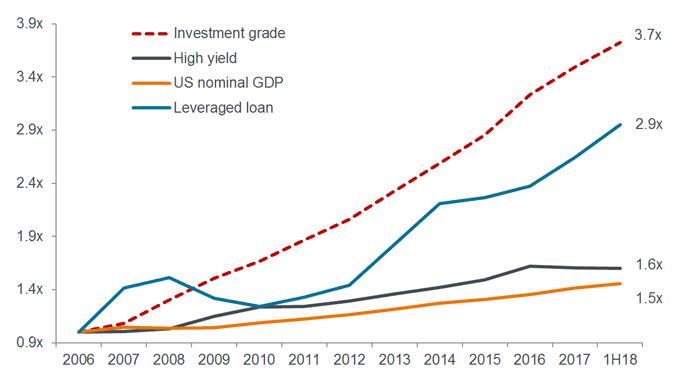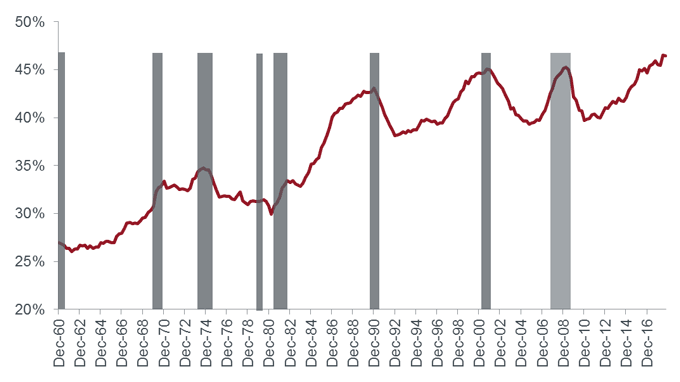Subscribe
Sign up for timely perspectives delivered to your inbox.
Portfolio Managers Darrell Watters and Mike Keough identify signals indicative of an advancing credit cycle and highlight what to watch in the year ahead.
The credit cycle has turned. Defaults have likely bottomed, and corporate credit spreads over Treasuries reached their tightest levels of this cycle in 2018. We are past peak opportunity, in our view, and advancing, albeit slowly, toward the cycle’s end. We may be in uncharted territory in terms of the length of this cycle, but the typical cracks are showing: high debt loads, tighter financial conditions and diminishing liquidity. Each cycle varies not only in duration, but also with respect to its drivers, and we believe the Federal Reserve (Fed)’s shift toward tighter monetary policy is the key catalyst this time around. While we cannot say how much longer the cycle can extend, we are certainly progressing toward its end.
According to the National Bureau of Economic Research, the last 11 business cycles have averaged just under six years. We are over nine years into the current cycle. The Fed’s unconventional monetary policy in the wake of the Global Financial Crisis has played a pivotal role in the extension. An unintended side effect of quantitative easing (QE) was a significant dampening of market volatility as the Fed injected liquidity through its asset purchases. QE also reduced term premiums – compensation investors receive for the additional risk associated with owning longer-dated bonds – and incited a willingness by investors to reach for yield where they may not have in the past. This environment, coupled with ultra-low interest rates, allowed corporate management teams to issue debt at will in their attempts to drive shareholder returns through mergers and acquisitions, share buybacks and bigger dividends.
The result has been a dramatic rise in corporate debt. Corporate debt-to-GDP has surpassed its previous peak, reaching 46% in the third quarter of 20181. Growth has been most pronounced in the US investment grade corporate credit market, which represents $6.4 trillion as of year-end2. Outstanding BBB debt comprises roughly half of that, compared with just 33% ten years ago2. Excesses in high yield have been less evident, and issuance in that market has generally declined in recent years. However, we have witnessed a shift in risk to the leveraged loan market, which has experienced significant growth and weakening credit quality as some highly indebted and lower quality issuers have chosen to finance deals there.
 Source: JP Morgan, June 30, 2018[/caption]
Source: JP Morgan, June 30, 2018[/caption]
Outsized leverage requires greater discipline by a company to maintain robust cash flows in order to service that debt. Once deteriorating fundamentals impact an issuer’s ability to execute on its commitments to bondholders, the credit rating agencies start taking action, as we saw in the last quarter of 2018. Even though leverage growth is often the result of equity-enhancing measures, we have also seen increasing instances of market value destruction. This rings alarm bells, in our view, indicating that investors are wary of supporting management teams that have stretched balance sheets in the face of weakening business fundamentals.
The world’s leading American multinational conglomerate has exhibited both challenges. The multinational conglomerate was downgraded to Baa1 from A2 by Moody’s, and to BBB from A by S&P in October. The company has been focused on creating shareholder value, returning roughly $80 billion3 of capital since 2015 in the form of stock buybacks and dividends. Yet, the stock has steadily declined, falling over 75% between December 2016 and December 20184. Despite the company’s efforts to wind down the balance sheet at subsidiary, the largest area of concern, the company’s capital adequacy has come into question while fundamentals have deteriorated across business lines. Through the stock price decline and wider credit spreads, investors are expressing concern over how the company will go about strengthening its balance sheet, which the new CEO has stated is the company’s highest priority. The market will be monitoring the company’s ability to delever and to execute assets sales to protect its credit ratings going forward.
As we extend through the cycle, we expect these types of idiosyncratic risks to increase. It is also typical for ratings agencies’ tolerance to decline for issuers that fail to meet their leverage targets, which will likely result in additional downgrades.
 Source: Federal Reserve, Bloomberg, National Bureau of Economic Research, September 30, 2018[/caption]
Source: Federal Reserve, Bloomberg, National Bureau of Economic Research, September 30, 2018[/caption]
It is important to note that higher corporate debt loads have been supported by robust earnings and strong cash flows. Overall corporate fundamentals were strong in 2018, with S&P 500 Index estimated earnings growth of 20.5% for the year according to FactSet6. Growth trends may moderate, now that Fed policy is less accommodative and the peak impact of US fiscal stimulus is behind us, but the outlook for fundamentals remains healthy. As opposed to deteriorating fundamentals driving us toward this cycle’s end, we are closely monitoring tightening financial conditions, which we expect to ultimately cause a contraction and subsequently challenge corporate fundamentals.
The Fed has raised interest rates nine times in its current hiking cycle. Inflationary pressures will play a pivotal role in assessing the likelihood of the Fed hiking in excess of what is warranted and potentially accelerating a slowdown versus it pausing in 2019. In our view, forces that hold back inflation will remain in play, allowing the Fed to moderate its pace and the number of future hikes. However, the direction of the US dollar will also be key. We are concerned that if growth does slow, deficits continue to rise and US government debt-to-GDP surpasses 100%, the dollar could face significant declines in 2019. This could threaten the benign inflation outlook, the Fed’s gradual normalisation and any further extension of the credit cycle.
In addition to rate hikes, the Fed has been reducing the size of its balance sheet for over a year. Other central banks are also removing accommodation. The European Central Bank stopped its asset purchase programme in December 2018, and both the Bank of Canada and the Bank of England raised interest rates last year. These shifts have been gradual, but they are removing liquidity from the system. Markets are reacting to the incremental changes, as reflected by increasing risk premiums and dramatic spread widening across the quality spectrum of corporate bonds in the last quarter of 2018.
Over the past few years, ultra-accommodative monetary policy around the globe had pushed investors in search of income toward higher yielding US assets. According to Fed data, foreign investors owned 28% of US corporate bonds in the second quarter of 20187, a larger share than either insurance companies or asset managers. As higher US rates drive up hedging costs and reduce the return potential of US assets, demand from these investors has shrunk. Further, real yields have risen and investors no longer have to reach as far for yield that outpaces inflation. Consequently, risk premiums are returning as investors demand greater compensation to hold lower quality assets.
Liquidity conditions and access to capital can change quickly in this environment. As risk aversion rises, the ability for investors to exit challenged positions will become increasingly more difficult. Wider spreads will create unfavourable issuing conditions and restrict access to capital. In December 2018, for example, high yield issuance was nil, and investment grade issuance was staggeringly low at $8 billion.8
While this credit cycle has certainly turned, we want to stress that we do not expect an imminent acceleration toward the cycle’s end. A deceleration in growth around the globe has given us reason to pause and must be monitored, but US economic growth remains constructive even as it slows. Given the economic backdrop and decent corporate fundamentals, we believe that a positive return environment is feasible for corporate credit in 2019, and that attractive investment opportunities can still arise.
Keeping a finger on the pulse of inflation, Fed rhetoric and resulting financial conditions will be critical in this late stage. Corporate earnings estimates and revisions will also be telltale signs of how near we are to the end. As idiosyncratic name risk intensifies, investors will need to be particularly mindful of issuers with stretched balance sheets and challenged fundamentals, and they should demand greater compensation for holding corporate credit as the risk of downgrades and defaults rises. The importance of risk mitigation will also grow, as access to capital becomes more restrictive and liquidity declines.
1 Source: Federal Reserve, Bloomberg, National Bureau of Economic Research, September 30, 2018
2 Source: ICE BofAML US Corporate Index, December 31, 2018
3 Source: Janus Henderson Research, December 2018
4 Source: Bloomberg, December 31, 2018
5 Source: Federal Reserve, Bloomberg, National Bureau of Economic Research, September 30, 2018
6 Source: FactSet, December 2018
7 Source: Federal Reserve, June 30, 2018
8 Source: JPMorgan, December 31, 2018